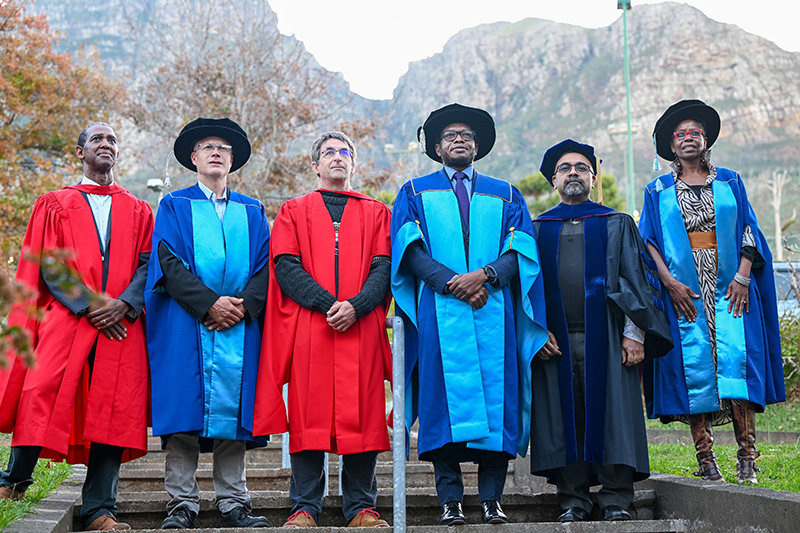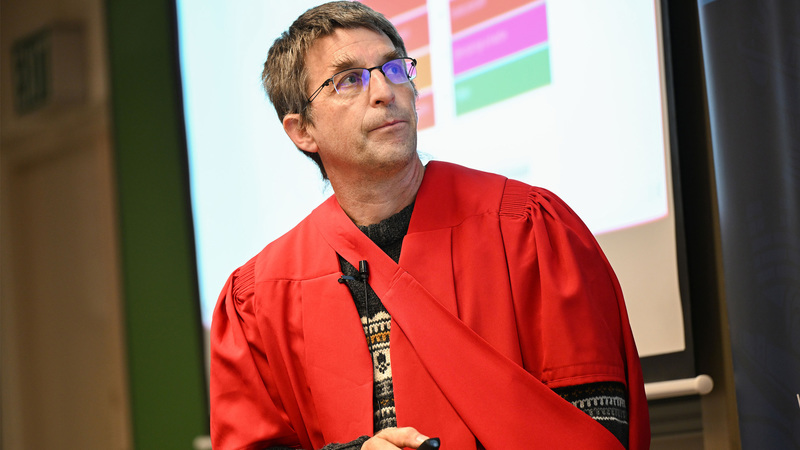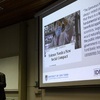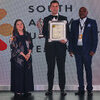How ecology, statistics and interdisciplinary collaboration can save species
13 May 2025 | Story Myolisi Gophe. Photos Lerato Maduna. Read time >10 min.In an era where environmental risks increasingly threaten economic stability and human livelihoods, statistical ecology plays a vital role in shaping effective conservation strategies. This was the key message by Professor Res Altwegg, founding director of the Centre for Statistics in Ecology, Environment and Conservation at the University of Cape Town’s (UCT) Department of Statistical Sciences, during his inaugural lecture on 8 May.
In a lecture, titled “Adventures in Statistical Ecology”, and delivered in a packed Lecture Theatre 2 in the Hoerikwaggo Building, Professor Altwegg explored the intersection of ecology, data science, and practical conservation.
With research interests ranging from amphibians in the Cape mountains to rhinos in the Kruger National Park, Altwegg offered insights into how scientific evidence and statistical modelling inform conservation decision-making. This raises the urgency of protecting biodiversity in an era of climate instability.
Why ecology and conservation matter
Referring to the World Economic Forum’s Global Risks Report 2025, Altwegg pointed out that six of the top 10 global threats over the next decade relate directly to environmental degradation, including biodiversity loss, extreme weather events, natural resource shortages, and ecosystem collapse.
“These are not people who are necessarily worried about nature per se. They worry about the global economy, but they understand that the economy and our livelihoods depend on the environment,” he explained.
Drawing from the Intergovernmental Panel on Climate Change (IPCC) 2023 synthesis report, Altwegg warned that we are headed toward a dangerous trajectory if mitigation and adaptation are not urgently scaled up. “We’re not currently on a sustainable pathway. We’re headed for high levels of global warming, weak international cooperation, and growing inequalities”.

Central to Altwegg’s research is the study of population ecology – the science of how populations change over time and space. Conservation science, he explained, focuses on four key drivers of population change: births, deaths, immigration, and emigration. “If we know these four quantities, we know how the population changes. So, a lot of my work is about estimating either some or all of these quantities.” This framework is the base of his work, from frogs in mountain pools to endangered megafauna like rhinos. With a background in evolutionary biology and statistical modelling, Altwegg uses a range of tools to estimate these parameters in complex, often fragmented ecosystems.
From house sparrows to frogs
Altwegg’s academic journey has taken him across the world, from Norway and Switzerland to Canada and, most recently, South Africa. He began his MSc research with house sparrows in Norway, examining metapopulations or populations spread across fragmented habitats connected by occasional movement of individuals.
For his PhD, he turned to frogs, whose lifecycle from aquatic tadpoles to terrestrial adults offers a unique model for studying life-history evolution and environmental effects. Frogs, he explained, provide a useful system for understanding how climate variability affects reproductive strategies, survival, and dispersal.
“What looks like a pattern may just be noise. That’s why we use statistical models to help us distinguish real trends from random variation.”
His research also extends to the microscopic level. During his time in Canada, he studied protists – single-celled eukaryotes – to explore predator–prey dynamics at the microscopic scale. These experiments helped uncover fundamental rules about interaction strength and feedback mechanisms in ecological networks.
Throughout the lecture, Altwegg stressed that conservation science is not just about observing nature – it’s also about overcoming biases in the data and how we perceive information in them. “What looks like a pattern may just be noise. That’s why we use statistical models to help us distinguish real trends from random variation.”
Altwegg now leads research projects focused on local biodiversity, including Rose’s mountain toad (Capensibufo rosei), a critically endangered amphibian found only in a few montane wetlands in the Western Cape.
These toads breed in short, intense windows during the rainy season. Using capture-mark-recapture (CMR) methods, he and his team track individuals across breeding seasons to estimate survival rates and population trends – with interesting results.
Their research showed that adult survival decreases during wetter years. “It’s counterintuitive. You’d think more rain would be better, but it turns out the energy costs of breeding, especially in wet, cold conditions, lead to higher adult mortality.”
Such findings have important conservation implications, he concluded. “If you want to manage these populations, you need to understand not just how many tadpoles are being produced, but how many adults are surviving from year to year,” he said.
Rhinos and conservation finance
Another example of Altwegg’s work is the Rhino Impact Investment Project, a multi-country initiative aimed at financing conservation through performance-based mechanisms. The idea is to attract funding from impact investors, who will receive returns based on the success of conservation outcomes, such as reduced poaching or increased birth rates.
He worked with teams who implemented a monitoring system that tracks individual rhinos using CMR methods. By identifying known individuals and recording births, deaths, and movements, the project can produce robust, time-sensitive data on population dynamics.
This data feeds into multi-state models, a statistical framework that allows researchers to estimate key parameters like survival and fecundity, even when animals go undetected for long periods.
“It’s about quantifying what’s actually happening on the ground so that funders, park managers, and policy makers can make informed decisions,” he said.
He also evaluated the effectiveness of various anti-poaching interventions in the Kruger National Park, such as dehorning, increased patrols, and fences. With the decline of rhinos around the African continent, the Kruger National Park is home to a large proportion of the global rhino population. So, if we lose them there, we might lose them for good.”
The results were revealing. “Dehorning had the strongest negative effect on poaching rate. Other interventions had some impact, but it was less consistent.”
Climate change reshaping bird body size and habitats
Birds are shrinking in size in response to rising temperatures, offering compelling evidence that climate change is driving evolutionary changes in wildlife, according to Altwegg.
More than 150 years ago, German biologist Carl Bergmann observed that larger animals tend to occur in colder climates, while smaller ones are more common in hotter regions. Known as Bergmann’s Rule, this idea has long been linked to how animals regulate heat. Smaller animals, with proportionally larger surface areas, dissipate heat more effectively – an advantage in warm environments.
But with global temperatures rising, a key question has emerged: Is climate change now selecting for smaller body sizes in birds?
Initially sceptical, Altwegg revisited this idea through an analysis of long-term bird monitoring data. Drawing on 25 years of meticulous CMR data from the work of late ornithologist Professor Steven Piper, researchers found that birds’ body mass had declined over time alongside a measurable rise in average temperatures.
Further analysis revealed that this change was not random. Larger birds had higher survival rates in colder years, while smaller birds thrived in hotter years – strong evidence of temperature-dependent natural selection.
“The pattern matched exactly what we would expect if body size change were an evolutionary response to warming.”
“This was quite surprising. But the pattern matched exactly what we would expect if body size change were an evolutionary response to warming.”
The research also explored bird populations in South Africa’s high-altitude grasslands, particularly the Ingula Nature Reserve, home to the Ingula Pumped Storage Scheme. This area provided a unique opportunity to study how land management practices, like controlled burning and grazing, affect bird habitats.
Through extensive fieldwork led by one of his PhD students, the research measured bird population density and habitat preferences. Different species showed clear preferences: some thrived in taller grass, while others preferred grazed or burned areas. The findings led to a management guide aimed at maintaining a mosaic of habitats to support biodiversity.
Beyond individual sites, Alwegg and his team used occupancy modelling to assess changes in bird populations across southern Africa. Drawing on citizen science data from the Southern African Bird Atlas Project, which collects nearly two million records annually, they tracked long-term trends in species distributions.
Analysis of 130 species revealed significant changes: species favouring wooded habitats were increasing, particularly in areas undergoing bush encroachment. Conversely, grassland species were in decline in these areas but increased in their prime habitat.
The research, rooted in collaboration between departments at UCT, highlights the value of long-term data and interdisciplinary approaches to conservation.
“This work was really a lot of collaboration between departments, and I think we should also strengthen our collaboration with other departments like Maths, Computer Science, Environmental and Geographical Sciences and Oceanography. There is still a lot to do in our field. It’s not just about understanding the past but supporting smart, data-driven decisions for the future. And it’s about training the next generation of scientists to do this work.”
 This work is licensed under a Creative Commons Attribution-NoDerivatives 4.0 International License.
This work is licensed under a Creative Commons Attribution-NoDerivatives 4.0 International License.
Please view the republishing articles page for more information.


















